1926 – 2005
Wenten grew up, in the area of the Alice Springs town and surrounding cattle stations, free of the traditional cultural strictures which affected most Hermannsburg School artists. He was not under the direct influence of either the Lutheran Finke River Mission or the senior Aboriginal men from the Mission’s area of influence around Hermannsburg and to the west. According to Wenten, both groups tended to be more strict culturally than those around Alice Springs. The author considers Wenten to have been a master of the Hermannsburg School style.
Wenten started to paint seriously in Alice Springs in 1960 after Albert Namatjira died in 1959. Throughout Wenten’s heavy drinking period in the 1960s through to 1976 he created glowing watercolour paintings, by the creek or in his beer garden ‘studios’, which were sold to fund drinking parties with his friends who watched as they waited to sell the new painting and share the proceeds. Many of these paintings are very engaging and intuitive and they reveal a talented, relaxed and sensitive personality.
Wenten’s life took on a new meaning in 1976 when he became an important leader of the Aboriginal land rights movement. Wenten was elected Chairman of the Central Land Council by August 1976. Despite pressure from family and friends, he stopped his heavy drinking to focus on his new role.
As a leader immersed in discussion and debate with a range of people, he came to understand more of other perspectives than maybe otherwise. Perhaps this affected his decision to paint more carefully in ‘two ways’, both elaborate pictorial watercolour landscapes and his version of Western Desert inspired acrylics.
He described the ‘dot art’ symbolic landscapes as ‘the law’ and the watercolour expressions of how the country looked as ‘the song’. His traditional paintings portrayed aspects of ancient traditional symbolism familiar to most Aboriginal people. In addition, some included figurative images of spears, boomerangs, snakes and lizards. A recurrent theme in his Hermannsburg style paintings was about finding a way, perhaps as in life.
While other Hermannsburg painters reflected the traditional and white cultures in one painting, Wenten after the mid 1970s achieved continual painting separately in two ways. In the late 1970s the general Hermannsburg School was losing some of its momentum as artists died or stopped painting. His extraordinary career continued through the 1980s and well into the 1990s.
From the mid 1970s, Wenten and artist Clem Abbott shared a compositional device of rocky cliffs framing each side, which thrusted toward the centre dramatically. However, Clem’s thrusting cliffs framed a distant and less intimate world which he described schematically with traditional decorative dot and line infill.
Wenten grew up in the Alice Springs area where his parents worked on stations and in the town area. Wenten lived at Little Flower Catholic Mission near Alice Springs in the early 1940s and was familiar with both Catholic and Lutheran teaching. From 1945 he lived near the Bungalow settlement on the Todd River near Alice Springs. In the late 1950s the Administration built a new settlement about fourteen kilometres south-east of Alice Springs at a location Arrernte people called Ipmengkwerene, and rendered ‘Ammoonguna’ by the Administration. [1]
Wenten managed to have a fairly flexible life working ‘where, when and with whom he liked’.
Details of his early life are unclear. It is estimated that Wenten Rubuntja was born in around 1926. However, he was listed as Winton Numaja in the Register of Wards of 13 May 1957, which recorded 1915 as the year of his birth. According to Wenten he was born at Burt’s Creek to the north of Alice Springs somewhere between 1923 and 1928. [2] Wenten was the son of Bob Rubuntja, a sheep and goat shepherd. Wenten Rubuntja was the major artist of the Rubuntja family.
According to Heritage, Wenten was Arrernte, Subsection (Skin) Pengarte. Wenten married Cynthia Uburtja in the late 1950s and shared a family connection with Clem Abbott as Clem’s mother was Katie Uburtja. Wenten and Cynthia’s son Mervyn, born 1959, became an artist in the watercolour tradition and is represented in the author’s collection.
Wenten and Ambrose Rubuntja were the sons of Bob Rubuntja, a goatherd. They were Arrernte, possibly Northern Arrernte. Subsection Pengarte. While Wenten had a career as an artist only a few paintings were created by Ambrose. A relative, Aubrey Rubuntja (born 31.10.1950) created a few paintings. Aubrey was the son of Eli and Leonore Rubuntja.
An oral evidence based auto-biography of Wenten’s life, co-authored with Jenny Green, was published in 2002.
Wenten’s first experiments with watercolour painting were probably in the late 1950s after watching Albert Namatjira paint. Albert was Wenten’s father’s cousin. Wenten was probably painting regularly from about 1960.
The earliest painting illustrated in the Wenten and Jenny Green book is from ‘circa’ 1968 and appears to be somewhat similar to Central Australian Landscape illustrated below. The three paintings at Araluen are undated but appear later than the illustration described as circa 1968. It is a challenge to estimate the approximate dates of Wenten’s paintings.
The earliest watercolour painting by Wenten to have been found is in Flinders University Art Museum 3125 and is apparently a memory or ‘studio’ painting: Untitled, est 1956-60 (watercolour on paper; 35.8 x 43 cm; signed lower left in fine paint brush in upper case: WENTEN RUBUNTJA). The author estimates that it was created around 1956 to 1960.
The composition contains an iconic mountain (possibly a version of Mt Gillen, near Alice Springs) and foreground red rocks thrusting towards the centre. The image is dominated by the gestural central tree. Form is more important than colour in this bicolour composition of red and blue, sometimes mixed to produce the muted colours. The painting is in a frame and there was no information on the backing of the frame. The image is stylised, indicating, perhaps, that this was not the artist’s first effort.
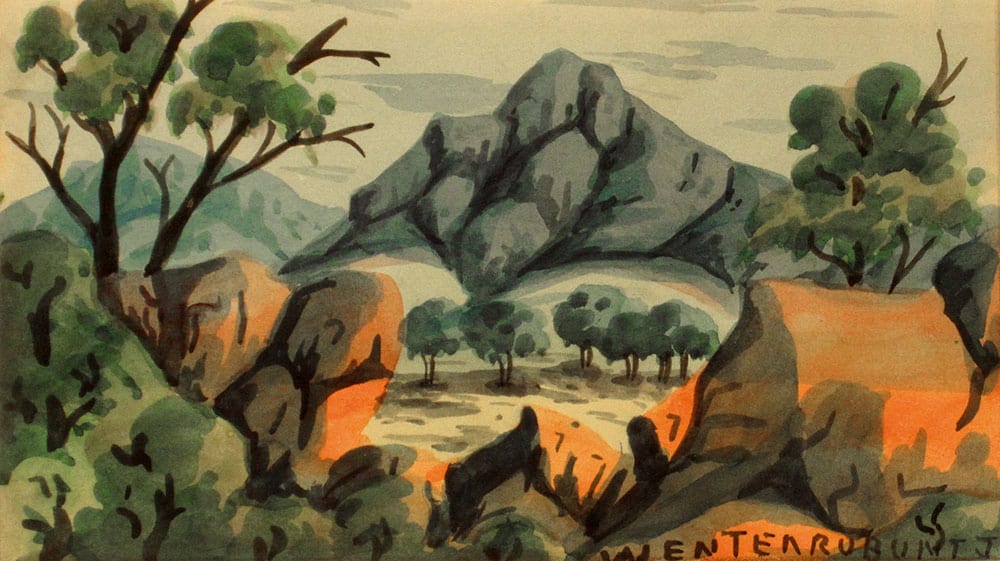
Central Australian landscape
Wenten Rubuntja
• • •
est. 1965-76
Watercolour on paperboard
14 x 25 cm
Beverley Castleman Collection
BDC-WRu-08
This appealing and glowing composition of an archetypal scene was apparently a painting done quickly to raise money for grog, during the artist’s heavy drinking period through the 1960s to 1976. It appears spontaneous and relaxed and was painted before a drinking party. Lemon is used carefully as a ground with red and ultramarine (with their greys) to impart a luminous quality.
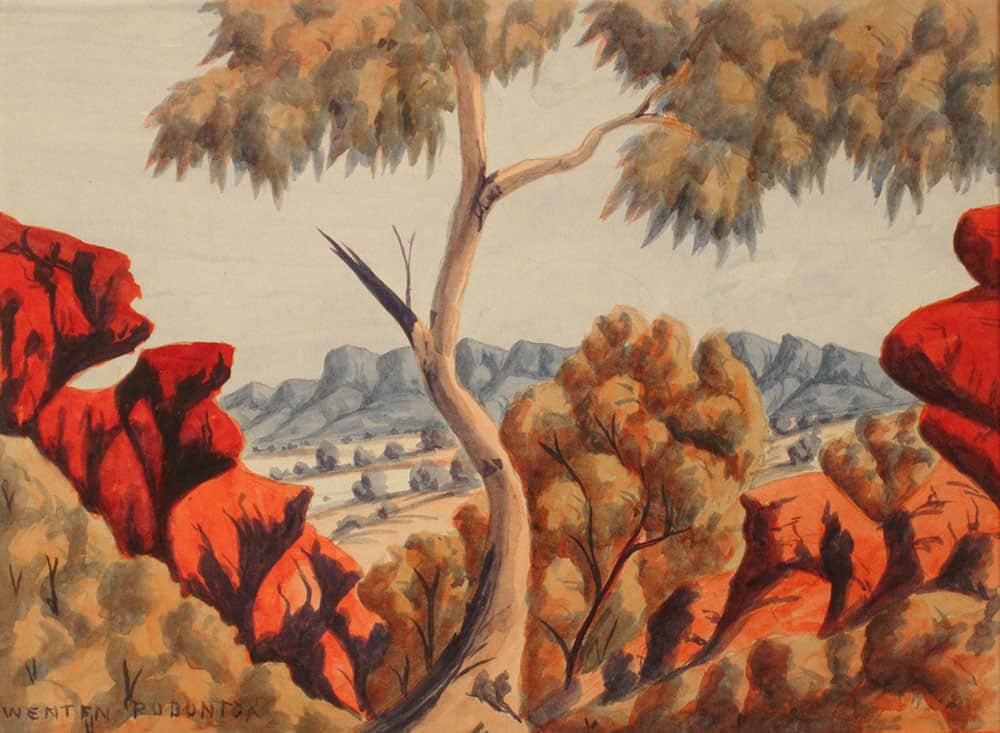
Untitled – Central tree
Wenten Rubuntja
• • •
est. 1965-76
Watercolour on paperboard
25 x 34 cm
Beverley Castleman Collection
BDC-WRu-07
This upbeat memory painting was created away from the scene of archetypal country. Wenten seems to have been in a ‘partying frame of mind’. Like many Arrernte paintings, this is somewhat symmetrical. A dramatic central curvy tree dances on high and is reminiscent of Otto Pareroultja’s single tree studies. Stylised red rocks frame the scene by pointing upwards toward the tree and with shadows toward the centre, although the tree and distant hills are sunlit from the right side. Ultramarine was used in shadows and foliage. A mellow appearance comes from orange yellow behind foreground foliage and big tree foliage.
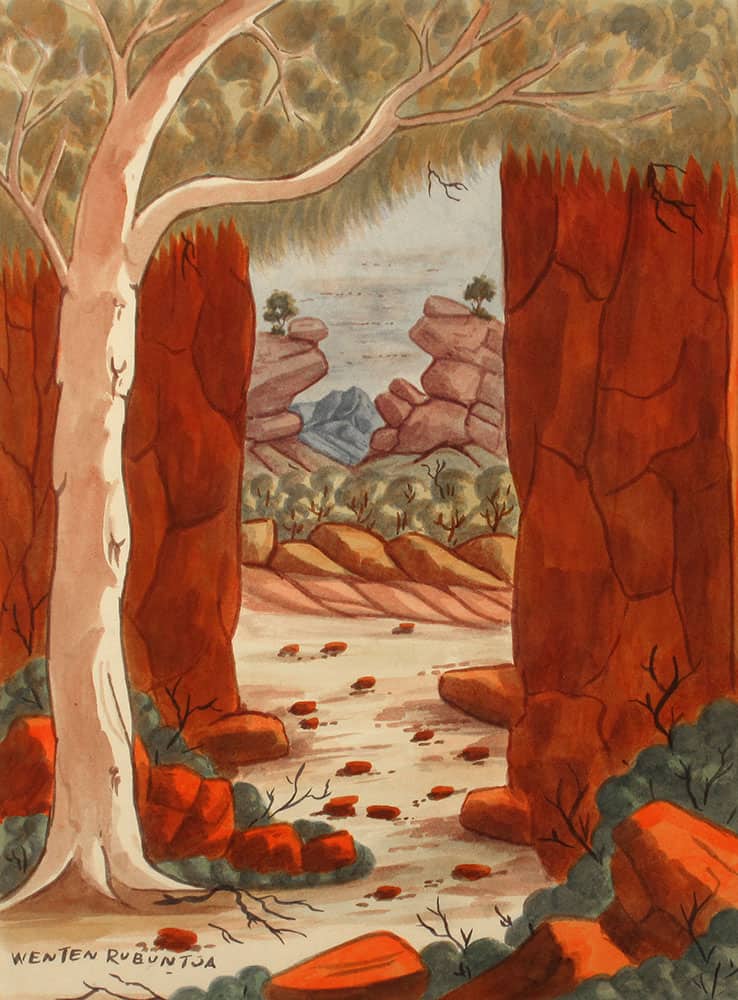
Central Australian landscape (possibly Standley Chasm)
Wenten Rubuntja
• • •
est. 1975-90
Watercolour on paperboard
49 x 36 cm
Beverley Castleman Collection
BDC-WRu-05
Wenten has depicted his own stylised interpretation of country through the gap in an archetypal chasm. The artist placed the walls of the chasm wide enough apart to leave space to portray his own version of the distant scene, revealing a strong sense of his own self. On passing along the path through the chasm the stroller cannot choose to proceed straight ahead as the way to the totemic outcrops is firmly screened off. The stroller must turn either down to the right or up to the left. Perhaps a correct way has to be found.
The white floor of the chasm has small scattered red rocks which appear significant and large red foreground rocks thrust toward the way through the chasm. The lower edge of the foliage of the big tree forms a ‘fringe’ across the top of curved parallels ending in points.
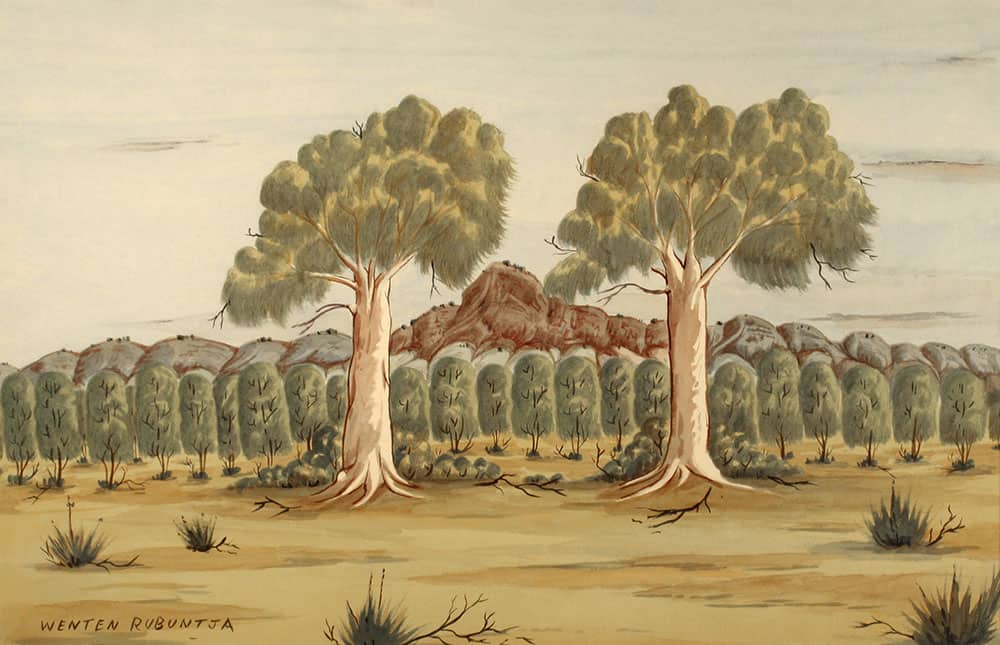
Perentie Trees – two brothers
(across from Simpson gap, Western MacDonnell Ranges) (inscribed verso)
Wenten Rubuntja
• • •
est. 1975-80
Watercolour on paperboard
48 x 74 cm
Beverley Castleman Collection
BDC-WRu-06
This interpretation confronts the viewer. Two ghost-gums on a bright lemon plain frame a view of a muted magenta totemic mountain. This composition has an emphatic screen of luminous lemon backlit trees extending from side to side, close to the two gums, but between the gums and mountain. Significantly, in contrast to many other paintings by Wenten, no pathway is shown inviting a stroller to enter the space between the big trees and mountain.
The screen of mid ground trees appears close behind the twin trees implying a vast plain between them and the hill, closer than appears from the Larapinta Drive. Perhaps they are brought forward as a ‘screen’ of the country beyond. There are rounded hills on each side of the twin gums. The hill between the gums is like the hill near Simpson’s Gap. There are no distant hills.
The name of painting: Perentie – Two brothers is suggestive of the twin gums near Simpson’s Gap in that the gap apparently is part of the Perentie dreaming story. The Big hART play Namatjira referred to Simpson’s Gap and the lizard men climbing the cliffs on each side of the gap. The word ‘perentie’ is Arrernte for the ‘big lizard’. The twin gums were almost destroyed by fire in January 2013. The fire was reported to have been lit deliberately. Fortunately they are regenerating.
Note: On 15 May 2015 the author visited the site. Turning north from Larapinta Drive into Darken Drive towards Simpsons Gap, there immediately on the left, stand the twin ghost gums behind scrub with the hill visible behind. There is much scrub but at least one of the twin gums is surviving, having reportedly been destroyed by the deliberately lit fire. The author took the photo from the road and did not attempt to walk into the scrub to check on the tree at the right. The trunk of the right tree is visible.
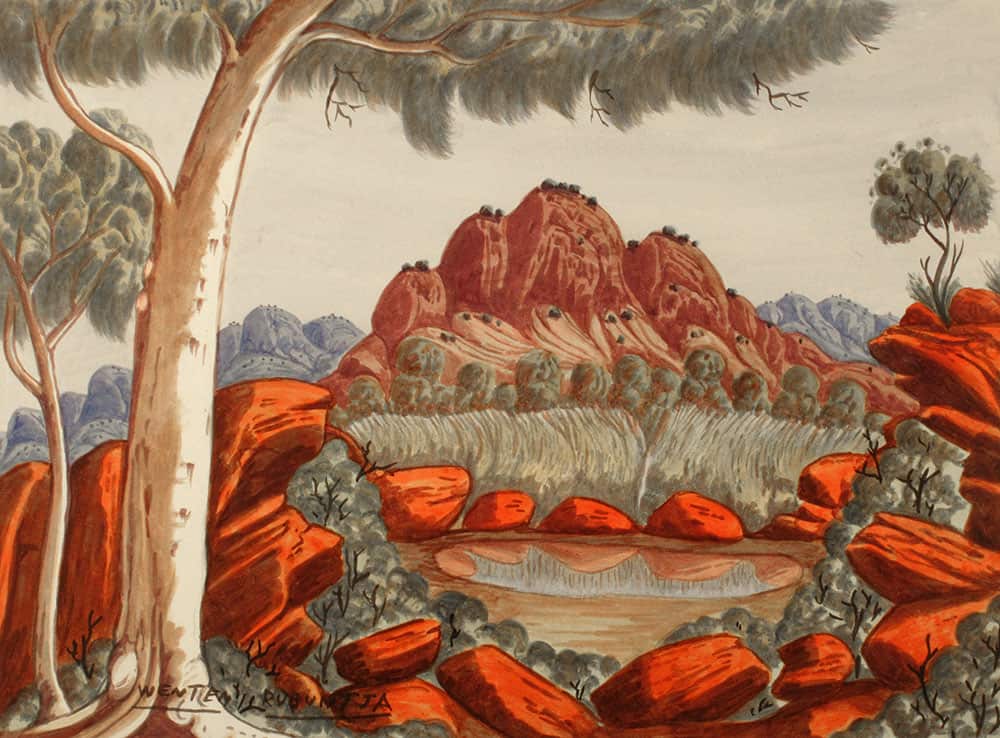
Untitled
Wenten Rubuntja
• • •
est. 1975-90
Watercolour on paperboard
35.5 x 47.5 cm
Beverley Castleman Collection
BDC-WRu-01
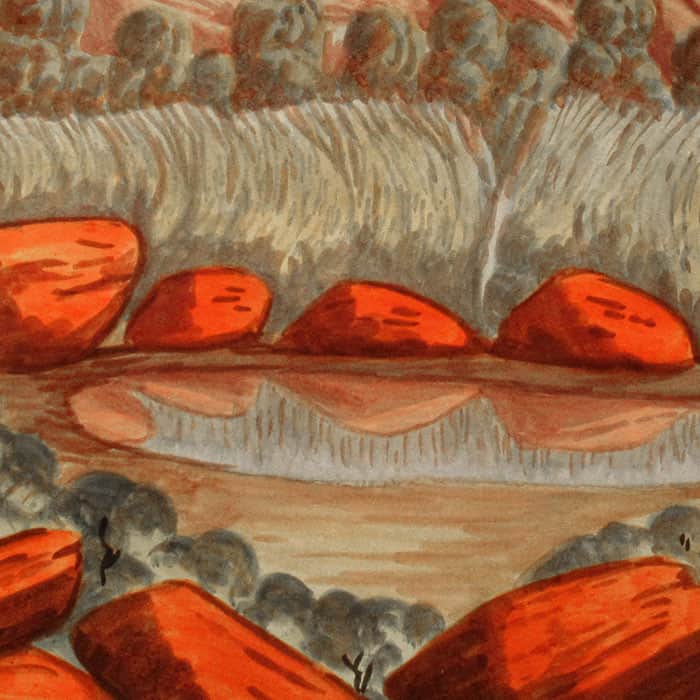
This captivating painting seems to be a ‘song’ about the artist’s elaborate symbolic and decorative screening which emphasises the important totemic hill. It is a place of great ceremony, the details of which we cannot know. The elaborate foreground screen of red rocks points to the hill. This is a stylised and idyllic fantasy. There is a hint of a path between the far side of the pool and the totemic ill.
Lemon-lit green foliage leads down to a water pool, which is screened behind with row of pointed red rocks, curved parallel verticals and row of blob trees. Above, the hill is screened by foliage of the big tree across the top with a lower fringe of curved parallels. The blue distant hills are an implied screen behind the totemic hill.
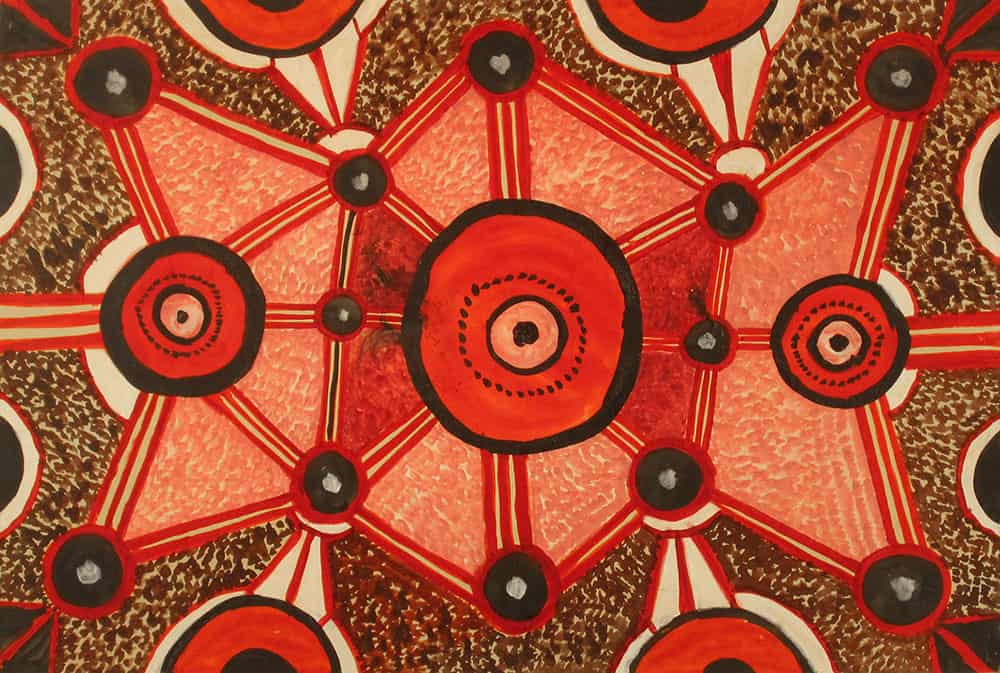
Ntaripe – Heavy Tree Gap
Wenten Rubuntja
• • •
est. 1976 (although Wenten and Green cite it as 1978 p 86)
Watercolour on board (apparently MDF)
35.5 x 52.8 cm
Beverley Castleman Collection
BDC-WRu-09
Apparently, this was a mind-clearing exercise employing his familiar medium of watercolour to experiment with the Western Desert style of painting employing ancient symbols, which was revived and facilitated at Papunya by Geoffrey Bardon from 1971.
In this painting Wenten was experimenting with traditional style inspired by art from Papunya. It is in watercolour, before he quickly changed to acrylic or polymer on canvas for his rendering of traditional expression, which he produced in parallel to his Hermannsburg style watercolours. As in his pictorial style watercolour paintings, luminous colour such as lemon yellow was used as a ground or a way of ‘back-lighting’ shapes expressed in the painting. This method of gaining a glowing effect remained a characteristic of Wenten’s art in the two ways he painted. In his later traditional styles he gained resonance by using vibrating colours side by side or as dots within dots.
This is quite a relaxed painting and the smudges of black were left as a spontaneous touch. Elements of acrylic method were used in the white dots over the bigger black dots. In his traditional styles, Wenten usually used traditional colours of red, yellow, black and white. However, through his watercolour experience he used crimson and lemon.
As illustrated and explained in the artist’s memoir and biography, the circle in the centre is Ntaripe (Heavitree Gap). The large circles on either side are Anthwerrke (Emily Gap) and Atheke Ulyele (Mount Gillen). This painting is notable because it was painted in watercolour but in the so called ‘dot’ style, and as such represents Wenten’s first experiments in his transition from painting in only watercolour to painting in Papunya inspired acrylics as well. Access to the painting for the book was courtesy of Rod Hagen, who was involved with the land claims movement as an anthropologist.
Wenten was one of the painters of the Barunga Statement (inspired by the Yirrkala Bark Petition 1963) to the Federal Government calling for a treaty that recognised Aboriginal people’s prior ownership of Australia.
The statement was presented by Wenten Rubuntja and Galarrwuy Yunipingu, the chairmen of the Central and Northern Land Councils respectively to Prime Minister Hawke in June 1988 at the Barunga Festival. The design of one side of the typed statement was painted by Wenten and two Walpiri men – Lindsay Turner Jampjinpa and Dennis Williams Japangaka from Central Australia. The three panels on the other side were painted by artists from Arnhem Land. The Barunga Statement was hung in Parliament House in 1991.
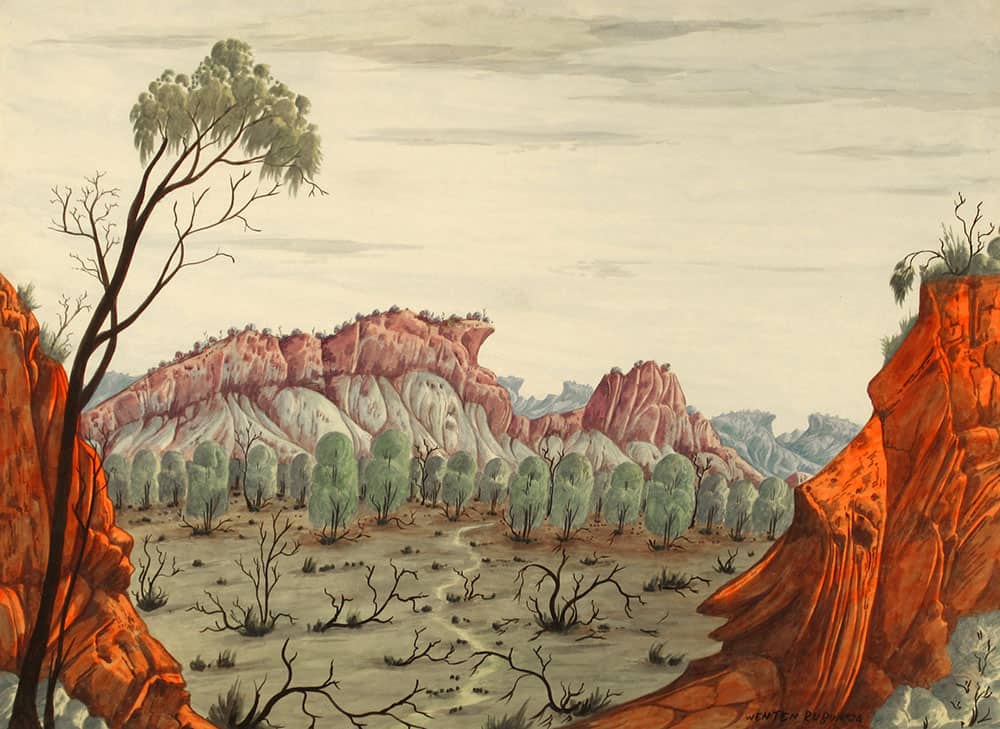
Rocky Outcrop Mt Ziel
Wenten Rubuntja
• • •
est. 1980-95
Watercolour on paperboard
54 x 74 cm
Beverley Castleman Collection
BDC-WRu-04
This is an idyllic yet calmly composed scene of regeneration of the archetypal country of Mt Ziel after a fire, or, perhaps of people a year or so after a metaphoric fire. This was painted a year or so before a scene of the same location. [3]on p151 of Wenten Rubuntja with Jenny Green)
The lemon underwashed, blackened plain is showing a tinge all over of green. The base of Mt Ziel is screened by regenerating blob trees, among which four blackened trunks still stand. There are remnants of blackened scrub on the front of the plain. The thin trunked blackened tree on the left has dead limbs but fresh foliage at top. High red rocks rise on each side and include an anthropomorphic ‘head’ on the right side.
A narrow lemon green track winds from foreground through a suitable part of the screen as if human feet in single file have disturbed the soot to reveal the clean earth and shooting grass. The range of hills behind Mt Ziel appears to screen it from behind. Magenta Mt Ziel has ultramarine blob trees on top and a cobalt blue over wash on the cliff area. The mauve lined base was tinged with lemon and pale green and there is lemon behind all foliage. The track from the viewer to a way through the row of trees seems symbolic, perhaps suggesting human regeneration as well.
REFERENCES TO EXTERNAL TEXTS
[1] Jenny Green with contributions from Tim Rowse The town grew up dancing: the life and art of Wenten Rubuntja p96 [2] Green, p14-15 [3] Green, p151
